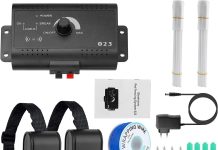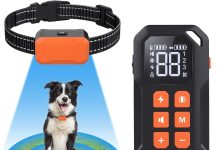Have you ever wondered if bark collars actually work for stopping excessive barking in pets? Well, we have too!
In this article, we will explore whether or not bark collars are truly effective in curbing this behavior. With various opinions and experiences floating around, it can be difficult to determine the most reliable solution.
So, let’s take a closer look at the effectiveness of bark collars and whether they can provide an efficient and humane solution for our furry friends’ excessive barking tendencies.
Overview of Bark Collars
Bark collars are devices designed to curb excessive barking in dogs. They are available in various types and work by utilizing different mechanisms. The primary goal of a bark collar is to discourage the dog from barking excessively and promote more desirable behavior. These collars can be a valuable tool for dog owners who are struggling with their pet’s incessant barking.
Table of Contents
Different types of bark collars
There are several types of bark collars available on the market. The most common ones include:
- Static Bark Collars: These collars deliver a mild static correction whenever the dog barks excessively. The level of correction can typically be adjusted to suit the dog’s sensitivity.
- Spray Bark Collars: These collars release a burst of citronella spray or other harmless substances when the dog barks excessively. The scent is unpleasant for the dog, serving as a deterrent to barking.
- Ultrasonic Bark Collars: These collars emit high-pitched ultrasonic sound waves that are only audible to dogs. The sound interrupts the barking pattern and encourages the dog to stop barking.
- Vibration Bark Collars: These collars vibrate when the dog barks excessively. The vibrations act as a distraction and discourage the dog from barking.
How bark collars work
Bark collars work by detecting the dog’s barking through various sensors. Once a bark is detected, the collar delivers a correction, whether through static, spray, ultrasonic sound, or vibration, depending on the type of collar. The aim is to interrupt the dog’s barking behavior and associate it with an unpleasant sensation or distraction.
Most bark collars are designed with safety features to ensure they are not triggered by other dogs or external noises. They are programmed to only respond to the specific sound frequency and intensity of the wearer’s barking.
Benefits of using bark collars
Using bark collars can have several benefits for dog owners and their pets. Some of the benefits include:
- Enhanced Training: Bark collars serve as a valuable training aid, helping dogs understand when excessive barking is undesirable. This can contribute to more effective overall training and better behavior.
- Reduced Neighbor Complaints: Excessive barking can strain relationships with neighbors, leading to complaints and tension. Bark collars can help mitigate this issue by reducing or eliminating excessive barking.
- Improved Quality of Life: Excessive barking can be stressful for both dogs and their owners. By addressing the problem with a bark collar, dogs can learn to associate barking with undesired consequences, leading to a calmer and more enjoyable living environment.
- Convenience: Bark collars offer a convenient solution for dog owners who may not always be able to address excessive barking through other training methods. Collars can be worn throughout the day, even when the owner is not present.
Effectiveness of Bark Collars
How effective are bark collars for stopping barking?
The effectiveness of bark collars in stopping excessive barking can vary depending on factors such as the individual dog, the type of collar used, and the training methods employed alongside the collar. While bark collars have shown promising results for many dogs, it is important to note that they may not work for every dog and may require some trial and error to find the most effective approach.
The majority of dog owners who have utilized bark collars report a noticeable reduction in their pet’s barking behavior. However, it is crucial to understand that bark collars should be used as part of a comprehensive training program to address the root cause of the barking and reinforce desirable behaviors.
Factors that can affect the effectiveness of bark collars
Several factors can influence the effectiveness of bark collars, including:
- Consistency: Consistent use of the bark collar is essential for achieving desired results. Inconsistency or sporadic use may confuse the dog and hinder the training process.
- Correct Fit: Ensuring the bark collar is fitted properly is crucial for its effectiveness. A collar that is too loose or too tight may not deliver the correction accurately or comfortably for the dog.
- Training Methods: Combining bark collar usage with appropriate training methods can significantly enhance its effectiveness. Positive reinforcement, distracting techniques, and obedience training can help reinforce the desired behavior and reduce barking.
Limitations and drawbacks of bark collars
While bark collars can be an effective tool for managing excessive barking, they do have some limitations. It is important to consider these drawbacks before using a bark collar:
- Individual Sensitivity: Dogs have different levels of sensitivity, and what may be effective for one dog may not work for another. Some dogs may become accustomed to the correction or find it ineffective over time.
- Potential for Misuse: Incorrect use or misuse of bark collars can lead to adverse effects or unwanted behaviors. It is essential to follow the manufacturer’s instructions and consult with professionals to ensure responsible usage.
- Masking Underlying Issues: Bark collars may suppress barking, but they may not address the underlying causes of the excessive barking. It is crucial to identify and address the root cause through training and behavior modification.
Choosing the Right Bark Collar
Considerations before buying a bark collar
When choosing a bark collar, it is important to consider the following factors:
- Dog’s Size and Breed: Different bark collars are designed for different sizes and breeds of dogs. It is essential to choose a collar that is suitable for the dog’s size and breed to ensure it is effective and comfortable.
- Type of Correction: Consider the type of correction that would be most appropriate for your dog. Some dogs may respond better to a spray or vibration collar, while others may require a static or ultrasonic collar.
Factors to look for in a bark collar
To ensure the effectiveness and safety of a bark collar, consider the following factors:
- Quality and Durability: Choose a bark collar from a reputable manufacturer to ensure quality and longevity. It should be able to withstand the wear and tear of everyday use.
- Adjustable Settings: Look for a bark collar with adjustable correction settings. This allows you to customize the level of correction based on your dog’s sensitivity and needs.
- Safety Features: Ensure the bark collar has safety features such as automatic shutoff after a certain duration or a sensor that prevents false triggering. These features help prevent overcorrection and keep your dog safe.
- Comfort and Fit: Opt for a bark collar that is comfortable and properly fits your dog. Look for adjustable straps and consider the material used to prevent discomfort or skin irritation.
Training Methods to Accompany Bark Collars
Positive reinforcement training
Positive reinforcement training involves rewarding the dog for desirable behavior and redirecting their attention from barking. When using a bark collar, combine it with positive reinforcement techniques such as treats, praise, and rewards to reinforce the desired behavior when the dog refrains from barking.
By associating positive experiences with not barking, your dog will learn that quiet behavior is more rewarding than excessive barking.
Distracting techniques
Distracting techniques involve redirecting the dog’s focus away from barking triggers. When the dog begins to bark, engage them in an activity or provide a distraction to divert their attention. This can include toys, puzzles, or playtime.
By providing alternative stimuli, the dog’s attention is shifted away from barking and towards more appropriate behavior.
Obedience training
Obedience training is essential for addressing excessive barking. Teaching your dog commands such as “quiet” or “enough” helps establish boundaries and reinforces the desired behavior. When your dog barks unnecessarily, use the commands to redirect their attention and encourage them to stop barking.
Combining obedience training with the use of bark collars can be highly effective in achieving long-term behavior modification.
Potential Side Effects and Risks
Physical discomfort for the dog
Some bark collars may cause physical discomfort for the dog, particularly those that deliver static corrections. It is important to choose a collar with adjustable settings, so the correction level can be tailored to the dog’s sensitivity. Regularly check the dog’s neck for any signs of irritation or discomfort, and adjust the collar if necessary.
Psychological effects on the dog
The use of bark collars, particularly those that deliver aversive stimuli, can potentially have psychological effects on the dog. It is important to closely monitor your dog’s behavior and demeanor when using a bark collar and discontinue use if any signs of distress or anxiety are observed.
Potential risks for certain breeds or individual dogs
Some breeds, particularly those with sensitive dispositions, may not respond well to bark collars or may require a different approach to training. It is important to consider the specific needs and characteristics of your dog before deciding to use a bark collar. Consulting with a professional dog trainer or veterinarian can provide valuable guidance in assessing the suitability of a bark collar for your dog.
Alternatives to Bark Collars
Environmental modifications
Modifying the dog’s environment can help address excessive barking. This can include creating a calm and stimulating environment, minimizing exposure to barking triggers, and ensuring the dog has ample physical and mental stimulation.
By addressing the underlying causes of barking through environmental modifications, you can reduce the need for a bark collar.
Citronella collars
Citronella collars are an alternative to traditional bark collars. These collars release a burst of citronella spray when the dog barks excessively. Citronella is unpleasant for dogs, and the scent serves as a deterrent to barking.
Citronella collars can be an effective option for dogs who are not responsive to other types of bark collars or for owners who prefer a more natural approach.
Ultrasonic devices
Ultrasonic devices emit high-frequency sound waves that are inaudible to humans but can be heard by dogs. These devices aim to interrupt the dog’s barking behavior and deter excessive barking.
Ultrasonic devices can be used in conjunction with other training methods to address barking effectively.
Using Bark Collars Responsibly
Consulting with a professional dog trainer or veterinarian
Before using a bark collar, it is advisable to consult with a professional dog trainer or veterinarian. They can provide guidance on whether a bark collar is suitable for your dog’s specific needs and offer advice on proper usage, training methods, and alternatives.
Proper fitting and placement of the collar
Ensuring the bark collar is properly fitted and positioned is crucial for its effectiveness and the dog’s comfort. Follow the manufacturer’s instructions carefully to ensure a snug fit without causing any discomfort or skin irritation. Regularly check the collar for proper positioning and adjust if necessary.
Regular monitoring and adjustment
Bark collars should be regularly monitored to ensure they are being used responsibly and effectively. Assess your dog’s response to the collar, watch for any signs of distress or discomfort, and make adjustments as needed. Additionally, periodically review the training methods and consider other approaches if necessary.
Case Studies and User Experiences
Success stories of using bark collars
Many dog owners have reported successful outcomes when using bark collars to address excessive barking. Stories of decreased barking, improved behavior, and enhanced quality of life for both dogs and owners are common. Bark collars, when used correctly and in combination with appropriate training methods, can be highly effective in curbing excessive barking.
Challenges faced by owners
While bark collars can be beneficial, some owners may face challenges during the training process. It is important to be patient and persistent, as it may take time for the dog to adjust and respond to the collar. Consistency in training methods and seeking expert advice can help overcome challenges and achieve desired results.
Expert opinions on bark collar effectiveness
Experts in canine behavior and training have varying opinions on the effectiveness of bark collars. While some emphasize the importance of ensuring appropriate training methods accompany the collar, others question the long-term efficacy and potential side effects.
It is valuable to consider a range of expert opinions, consult with professionals in the field, and carefully evaluate the specific needs and characteristics of your dog before deciding to use a bark collar.
Legal and Ethical Considerations
Legality of using bark collars in certain areas
The use of bark collars may be subject to legal restrictions in certain areas. It is essential to familiarize yourself with local regulations before using a bark collar to ensure compliance with the law. Failure to do so may result in legal consequences and penalties.
Ethical concerns related to training methods
The use of corrective training methods, including bark collars, raises ethical considerations. It is important to approach training with compassion, understanding, and a focus on the overall well-being of the dog. Responsible usage of bark collars, combined with positive reinforcement and appropriate training techniques, can help address barking without compromising the dog’s welfare.
Conclusion
Bark collars can be a useful tool in addressing excessive barking in dogs, promoting better behavior and a harmonious living environment. However, they should be used responsibly and as part of a comprehensive training program that includes positive reinforcement, distracting techniques, and obedience training.
Consideration should be given to the specific needs and characteristics of the dog, and professional guidance sought when necessary. Additionally, alternatives such as environmental modifications, citronella collars, or ultrasonic devices can be explored. Ultimately, approaching the use of bark collars responsibly and ethically contributes to their effectiveness and the overall well-being of the dog.



































